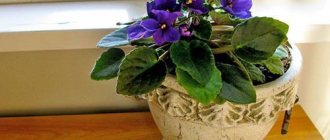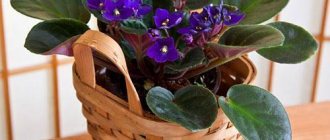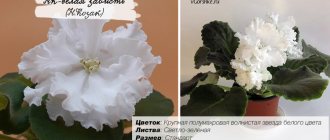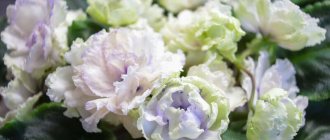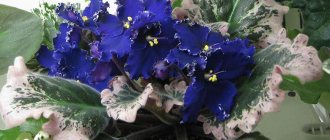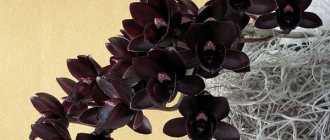Beginner Saintpaulia lovers are amazed at the richness of color and size of varietal flowers. Meanwhile, experienced flower growers know that there are a great many varieties of violets, and, in addition to colors, plants differ in the shape of the corolla, the size and structure of the rosette. And we continue our acquaintance with just a small part of these unique indoor flowers, which began in the previous four articles with photos and names of violet varieties.
Violet Blue Blood
The Blue Blood violet, obtained thanks to the breeding work of E. Korshunova, belongs to the Saintpaulias of standard size. The rosette of this variety that amazes the viewer consists of simple rounded leaves of rich green color.
The flowers, like many other varieties of Korshunova’s selection, are very large. Their obvious advantage is the semi-double corolla, wavy along the edge, and the unusual blue tint of the background color. The petals are edged with a thin white border.
Cultivation and maintenance
The best place for violets is on the window sills facing west or east. For better lighting, they are periodically rotated. To ensure constant flowering, use dim artificial light. Sudden temperature changes are contraindicated for these sensitive flowers. With the onset of cold weather, so that the violets do not weaken, they are removed from the windowsills.
Yellow Saintpaulias are very delicate flowers. They must be watered carefully and always with water at room temperature. Do not allow the soil to dry out or become excessively wet. This will harm the plant.
Watering is carried out along the edge of the flower pot so that water does not fall on the petals. In winter, watering can be limited.
It is enough to feed Saintpaulia once every 2 weeks during flowering. The plant is fertilized simultaneously with watering. Mineral fertilizer with a predominance of phosphorus is used. Spraying is not recommended. To create sufficient moisture for the flower, the pot with it is placed on a moistened tray with fillers.
There are two ways to propagate violets at home:
- leaf cuttings;
- daughter sockets.
Cuttings are the simplest and most common method. A good and strong leaf with a cutting length of up to 3 cm is kept in water until roots form. Then it is planted in the soil at a shallow depth (up to 2 cm) and watered with warm water. Frequent replanting is not required (once a year). The soil base for growing violets is purchased in specialized stores.
Violet Irish flirt
The star-shaped, double flowers of the Irish flirt violet, bred by S. Sorano, are miniature roses of an unusual white-green color. The edges of the petals on the corollas are densely corrugated, which only complements the similarity of Saintpaulia to a noble garden flower. The green tint becomes thicker towards the edge of the petals, forming a decorative wavy frill.
The variety belongs to a miniature variety of violets. Flowering in the form of a cap, abundant. The flowers do not scatter and retain the appearance of a small, neat bouquet.
Features of the view
The root system of this species develops poorly in length. Therefore, she does not do her job for long. As the plant grows, the roots are renewed: old ones are replaced by new ones. As a result, violets should be planted in small pots that restrict the roots and allow maximum air access to the flower. The drainage layer and the presence of holes in the pot also contribute to this.
The variety of violet varieties is amazing. They come in different appearances: with or without a border around the edges, star-shaped, corrugated or plain. Based on the leaves, they are divided into female and male types.
The male type has uniform green leaves, while the female type has a light spot on the upper side of the leaf.
Violet Nautilus
E. Korshunova often pleases flower growers with unusual varieties. is no exception , forcing you to study the unique colors of the petals without taking your eyes off.
According to the author's description, the semi-double flowers of this variety are star-shaped and stand out with fancy scalloped petals. The color of the flowers is also no less remarkable, because it combines white, blue and deep blue tones. The border on the petals is white or greenish. The foliage has slightly wavy edges and a deep green color.
Features of development and flowering
When maintaining the variety, flower growers note the absence of unpleasant flaws in its “nurture” , rich flowering, and also rare sportiness.
Among the successful features of the author’s presentation of the variety, the following should be highlighted:
- independence of growth until the elegant outlines of the rosette appear;
- a sophisticated combination of the lush wavy greenery of the bushes with the sunshine of the flower caps;
- sufficient diligence during the flowering process;
- a large number of newly formed peduncles and buds.
Flower growers classify violet as a variety that has virtually no obvious drawbacks. But it is important to pay attention to:
- some slowness of instances;
- possible sporting;
- slight tendency to bend the edges of the leaves towards the flowerpot;
- thinness of peduncles.
Problem-free propagation of the variety is ensured by the good education of the children.
The decorative coloring of the petals is practically independent of differences in the temperature parameters of the microclimate of the collections.
CAREFULLY! Saintpaulia bears its buds on thin stalks, so the flowers can fall on the leaves.
The sunny variety has airy silhouettes of rich caps.
The lifespan of the corollas of the variety is about a month , which is excellent for a yellow variety.
Violet Playful spectrum
The Sorano selection includes many varieties that are happily grown by flower growers in different countries. The Playful spectrum violet, standard in rosette size, reveals single or semi-double, large flowers with a wide white eye and pink-lavender coloring of the petals. Blue fantasy spots are generously scattered along the corolla. The flower shape is a star. The color of the foliage is even, green.
Under certain conditions, the Playful spectrum violet, even with vegetative propagation, is capable of producing offspring with flowers of a different color. Such plants are called sports or, as in this case, chimeras. The variety of violet shown in the photo has clearly visible lilac stripes in the center of the petals, which is not characteristic of the varietal plant.
Care in the home microclimate
Specimens of the varietal variety of violets in indoor gatherings demonstrate a very problem-free nature:
- that are most beneficial for violets are those that are located on the southeast side - here the plants are most illuminated. The windows on the south side of the house are better illuminated in winter, but in summer severe overheating is noticeable there, which threatens the plants with burns.
Therefore, it is recommended to slightly shade the windows during midday heat. Window sills in the eastern and western directions are considered semi-shaded; here the sun's rays are available to violets only in the first half of the day. Northern windows are the worst suited for placing violets, and then only if they are equipped with additional lighting; - watering the variety should not be carried out too often while simultaneously monitoring the drying of the top layer of the substrate in the flowerpot;
- additional nutrition with mineral fertilizers at a particular moment in time or not, showing their internal state with a decorative appearance.
In the same way, you can find out the plant’s need for certain types of fertilizers. But this procedure of agrotechnical care cannot be abused; - An important role in the life processes of specimens of the variety is played by the optimal lighting regime with a well-chosen structure. For proper growth and healthy flowering, it is necessary to combine long-term illumination of the plant with a natural spectrum with exposure to LED lighting;
- the possible temperature gradient is +20 + 24°C. It is important to prevent its extraordinary jumps and cold drafts;
- timely provision of plants in the home collection with fresh substrate is a necessary condition for maintaining the health of the specimen - this ensures aeration and water permeability of the soil. In addition, a good drainage system is needed;
- For replanting, it is more correct to use “transshipment”, although it is suitable when working only with healthy violets.
Violet Lord of the Rings
The popularity of Tolkien's famous novel is reflected in the names of violet varieties. For example, the Lord of the Rings violet created by K. Morev, in the photo, gives its owners huge light lilac flowers with a wide white eye in the center of the corolla. The light spot is bordered by a thin purple stripe. Why not a ring kept by a hobbit?
The flower shape is star-shaped, semi-double. The wavy purple edge of the petals is emphasized by a white or light green frill. The foliage of the standard rosette is light, round, quilted.
The Lord of the Rings violet shown in the second photo belongs to the selection of E. Korshunova, who was also inspired by the exciting story. True, her Saintpaulia is completely different, with gigantic flowers up to 7 cm in diameter in the shape of a regular double star. The corollas are painted a deep blue color, which loses intensity towards the edges of the petals, becoming snow-white. The standard sized rosette consists of quilted green foliage.
Violet Mellow Yellow (P. Sorano)
The author who registered the deliciously sunny variety is breeder Paul Sorano .
The variety was bred in the Lyndon Lyon Greenhouse owned by the Sorano family in the town of Dolgeville (New York, USA), which Paul has managed since 1982, after the retirement of his grandfather Lyndon Waldo Lyon, the founder of the beautiful family business.
The violet was introduced to flower growers and is highly valued by admirers of Saintpaulias with yellow corollas.
The luminous variety of violet is recorded in the genus Saintpaulia, which is part of the extensive Gesneriaceae family.
The rosette of the presented variation of violet is included in the system of subspecies of standard sizes , and according to the structure of the corollas, the plant is simultaneously built into the subcategory of varieties of double appearance.
Photo and description of the variety
A delightful violet, after final and long-term strengthening in the form of an adult plant, can take the form of a bush, intelligently arranged with a neat tiled arrangement of leaf plates, having a relief-symmetrical configuration of shapes and creating remarkably voluminous outlines of flower caps.
ATTENTION! The sunny violet acquires a chic varietal silhouette of compact outlines remarkably smoothly, but rather slowly.
An important feature of its growth is its calm and light character : a spectacular-looking rosette forms independently, Saintpaulia does not show whims regarding slight fluctuations in agrotechnical conditions.
According to the author’s description, included in the world registers of violet growing, it is planned for Saintpaulia to maintain a level gradient of standard scales , which plants in cultivation almost always strictly observe.
Medium-sized violet leaves are characterized by a textured quilted, fuzzy-matte layer, a design of wavy-rounded “hearts” with a barely visible hint of the presence of a sharply shaped end, and a graphically pressed pattern of venation, which attracts attention due to the excessive tuberosity of the structural pattern and a significant density of vein lines .
The edges of the remarkably wavy leaves are delicately framed with neatly sculpted, rounded-medium teeth. The texture of the plates is dense and juicy .
INTERESTING! There is a slight bending of the edges of the leaves towards the flowerpot.
The color of the leaves of violet bushes is consistent in light variations of the malachite-green palette. The reverse side has a faint silver coating .
The varietal Saintpaulia is characterized by a fairly abundant process of blooming of remarkably double flowers , allocated to the “star” segment, as well as a noticeable waviness in the texture of the corollas and a watercolor-artistic depiction of their sunny color of the petals.
The corollas are small in size and have wavy petals with expressively fringed frills along the edges, which in general, with their multiple numbers, creates a feeling of lush and airy fullness of the flower caps.
The color scheme of Saintpaulia corollas is based on decorating their petals of a basic yellowish color of varying intensity with brighter, sunny yellow veins diverging in all directions from the center, as well as chaotically appearing watercolor spots in light lemon shades.
In the center of the corollas there are eyes of a juicy yellow color scheme. The petals have a sugar-sparkling texture, which enhances the airiness of the flower caps.
The outer petals of the buds have a slight greenish tint. themselves can take a long time to open.
NOTABLE! When fully bloomed, the violet corollas resemble double rose hips.
Sports
Violet prefers the extremely rare creation of sporty variations with corollas painted in shades of pink.
Protection and prevention
When there is insufficient light, yellow spots may appear on the top of the leaf. This is a sign of rust. During the hot summer period, bacteriosis is possible. This causes brown spots to appear on the stem and leaves. They become soft and darken. With powdery mildew, a white coating appears on the petioles and leaves. With false dew, plaque appears on the lower leaf part.
If such signs appear, all damaged areas of the plant must be removed. The soil and other parts of it are treated with fungicides. For prevention, it is necessary to monitor the balance of fertilizers in the soil. Before planting, treat the soil with fungicides. If you decide to start growing violets, then it is better to refuse large and beautiful exhibition varieties, as some difficulties may arise during cultivation. It is better to start with small miniature violets.
They are original, unpretentious and extremely beautiful.
See the video below for expert advice on caring for violets.
